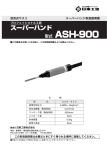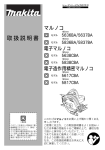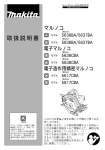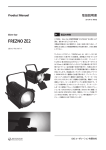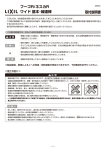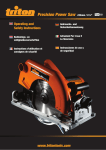Download Sanyo Denki ASD100S2U Specifications
Transcript
Technical Material Overview and characteristics of fan Overview A cooling fan is widely used to extend life of your system by cooling off heat of the system that many electrical components are mounted in a very high density and dissipating heat. Since we Sanyo Denki developed San Ace which is the first AC fan in Japan in 1965, we have increased fan motor lineup until now meeting customer s needs rapidly based on our tremendous career. We Sanyo Denki will continue to develop new fans with high air flow, low noise, low vibration, and energy - saving design. Characteristics We can roughly devide fan into two types which are AC and DC. AC Fans DC Fans Sanyo Denki succeeded in the mass-production of AC fans in 1965. Sanyo Denki was the first Japanese manufacturer to have succeeded at this. ●High performance ●High reliability ●Safety Sanyo Denki succeeded in the mass-production of DC fans in 1982. ●High performance ●Low power consumption ●Low vibration ●Low leakage of flux ●High reliability Sanyo Denki currently has a wider variety of products like Long Life Fan, CPU cooler, Splash Proof Fan, and Oil Proof Fan etc to meet all customer needs. Guideline in selecting a fan How to select an appropriate fan The following example is a guideline regarding how to select an appropriate fan for cooling your system 1. Determining of your system specifications and conditions Determine the temperature rise inside your system and obtain the total heating value inside your system on the basis of its inputs and outputs. Example V : Total heating value of your system(W)=100(W) △T : Inside temperature rise(K)=15(K) System Fan ℃ T Q' V 2. Calculating the Required Air flow for Cooling Heat source After the equipment specifications and conditions of your system have been determined, calculate required air flow to meet the conditions. (Note that the formula shown below only applies when the heat radiation is performed only by cooling air from the fan.) Example Q': Motion air flow(m3/min) V 100(W) ≒0.33(m3/min) Q = = 20×15(K) 20△T 3. Selecting the Fan After the motion air flow has been calculated, select an appropriate fan motor based on the value.The motion air flow when the fan motor is actually mounted in your system can be obtained using the air flow-static pressure characteristics curve and system impedance. However, the system impedance cannot be measured without a measuring equipment, so fan with 1.5 to 2 times higher air flow than the actual Max air flow should be selected (operating air flow is one-third to two-thirds of maximum air flow). Example Q: Maximum air flow(m3/min) Characteristics of air flow versus static pressure Q =Q×2/3 Q=Q ×3/2=0.33×3/2≒0.5(m3/min) Next, In case that you select a fan having an air flow of 0.5 (m3/min) or more and a appropriate size for the space inside your system. For example, If you need a fan of 60mm square, 25mm thickness and 12V, you should select is 109R0612H402 (maximum air flow = 0.53m3/min). 4. Confirming the Selected Fan Calculate the temperature rise inside your sysetem when your sysetem having 100 (W) of total heating value is forcefully cooled down by a 109R0612H402 fan. Example Q =Q×2/3=0.53×2/3≒0.353(m3/min) △T =V/20Q =100(W)/20×0.353(m3/min)≒14.2(K) From the above, the temperature rise inside your system is calculated as 14.2(K). and those of pressure losses of equipment Static pressure System impedance Pressure loss Operating air flow Air flow Since the value obtained from the above equation is only a rough target, final fan selection should be based on your actual installation test. 347 Characteristics calculation method and description Reliability and Life Expectancy conducted on the basis of the concept that the expected life halves as the ambient temperature rises by about 15℃ (within the operating temperature range of lubricant.) Expected life of DC Fans Expected life (h) A cooling fan generally cools itself as well. The temperature rise of the motor is relatively low and the temperature rise of the grease in the bearings is also low, so expected life is longer than general some either motors. Since the service life of bearings is a theoretical value that applies when they are ideally lubricated, the life of lubricant can be regarded as expected life of the fan. DC fan consumes less power and its temperature rise of bearing is very low, thus its expected life is 40,000 hours at an ambient temperature of 60℃(60,000 hours for some models). Sanyo Denki also has a line-up of long life fans that has 200,000 hours life and 100,000 hours life at an ambient temperature 60℃ with an even more enhanced structure and material. When the measurement conditions are: L10 (the remaining product life in the lifespan test is 90%),with an atmospheric temperature of 60 degrees, at the rated voltage, and continuously run in a free air state. The table below indicates the relationship between ambient temperature and expected life estimated on the basis of our life tests and same other tests conducted by Sanyo Denki. An accelerated life test is 1,000,000 Expected life 200,000h (L10, 60͠) Expected life 80,000h (L10, 60͠) Expected life 180,000h (L10, 60͠) Expected life 60,000h (L10, 60͠) Expected life 100,000h (L10, 60͠) 100,000 Expected life 40,000h (L10, 60͠) 10,000 Expected life 30,000h (L10, 60͠) 1,000 20 40 60 80 100 Ambient temperature (͠) Rated voltage, continuously run in a free air state, survival rate of 90% Noise characteristics Noise is average value that measured at l meter away from air intake side of fan that is suspended on special frame in anechoic chamber (as per JIS B 8330). Fan Noise meter 1m Technical Material AIR FLOW Acoustic radio wave anechoic chamber Noise characteristic measurement equipment Measuring air flow and static pressure It is very difficult to measure air flow and static pressure. In fact, the performance curve may vary greatly according to the type of measuring equiment. The commonly-used type of measuring equipment is a wind tunnel using a Pitot tube. Sanyo Denki uses a very precise method using double chamber equipped with many nozzles. U-shaped tube Throttle device Pn Ps Chamber B U-shaped tube Q =60A v¯( A) where Q = air flow(m3/min) π D2(m2) A = cross sectional area of nozzle=− 4 D = nozzle diameter ─(m/sec) v¯ = average air flow velocity of nozzle= 2g Pn γ γ : Air specific gravity(kg/m3) (γ=1.2kg/m3 at 20℃ , 1 atmospheric pressure) g = acceleration of gravity = 9.8(m/sec2) Pn= differential pressure(mm H2O) Ps = static pressure(mm H2O) Chamber A Nozzle BM Auxiliary blower Fan to be measured Double chamber measuring equipment The measuring equipment using double chanber is method to be calculated from air flow goes through nozzle and differential pressure between pressure of inside of chamber (Ps) and atomospheric pressure by measuring differetial pressure between air intake and exhaust of nozzle (Pn). Conversion Table Static pressure 1mm H2O=0.0394inch H2O 1mm H2O=9.8Pa(Pascal) 1inch H2O=25.4mm H2O 1Pa=0.102mm H2O 1inch H2O=249Pa Air flow 1m3/min=35.31ft 3/min(CFM) 1CFM=0.0283m3/min 1m3/min=16.67ℓ /sec 1CFM=0.472ℓ /sec 1ℓ /sec=0.06m3/min 348 Technical Material DC Fan Common Specifications Material ‥‥‥‥‥‥‥‥‥Frame,Impeller:Plastics / Frame:Aluminum,Impeller:Plastics * For details, refer to the appropriate page. Life Expectancy ‥‥‥‥‥Varies for each model (L10:Survival rate:90% at 60℃ ,rated voltage, and continuously run in a free air state) * Splash proof fan: Varies for each model (Indoor, L10:Survival rate:90% at 60 ℃ ,rated voltage, and continuously run in a free air state) Motor Protection ‥‥‥‥‥Burnout protection at locked rotor condition and Reverse polarity protection Dielectric Strength ‥‥‥AC50/60Hz 500VAC 1minute(between lead conductor and frame) Insulation Resistance ‥‥10MΩ or more at 500VDC megger (between lead conductor and frame) Sound Pressure Level(SPL) ‥Expressed as the value at 1m from air inlet side Storage Temperature ‥‥-20℃ to +70℃ / -30℃ to +70℃ (Varies depending on models. Non-condensing) Lead Wire ‥‥‥‥‥‥‥‥For details, refer to the appropriate page. Overheating protection function Protection Functions: If the fan blades are restricted, an overcurrent occurs and leads to a rise in the fan coil temperature. This can result in reduced performance, damage, or a fire. To prevent this from occurring, Sanyo Denki s fans incorporate an overheating protection function. Refer to the catalog for the types of protection functions. Burnout protection function at locked rotor condition ● Current cutoff system If the fan blades are restricted, the coil current is cut off at regular cycles to prevent overheating of the coil. When the hindrance is removed, the fan restarts automatically. (For the San Ace 200〈Model. No: 9EC20****, 9GV20****〉, however, the power needs to be turned off and on again to restart.). Reverse polarity protection function No problem about fan even if positive & negative lead are connected in reverse. (However fans with sensor & speed control are excluded.) Specifications for DC fan sensors Pulse sensor (Tach output type) example Pulse sensor outputs two pulse waves per revolution of fan, and it is good to detect fan speed. Pulse sensors can be incorporated in all kinds of DC fans. * Noise from inside the fan or from external devices may effect sensor output. Contact us for more information. The special IC that detects a pulse sensor and raises the alarm is available. Refer to page 346. ● Typical standard model: 9G1212H101. Output circuit Output waveform(Need Open collector One revolution T0 Specifications VCE=+30V MAX. T1 (For a 48V-rated fan:Vce=+60V MAX.) Ic=10mA MAX.[Vol=Vce(SAT)=0.4V or less] Inside of DC fan SENSOR T2 T3 T4 VOH VOL 0V + ○ Resistor +30V MAX. T1 to 4≒ (1/4) T0 T1 to 4≒ (1/4) T0=60/4N (sec) -1 N=Fan speed (min ) Ic=10mA MAX. Sensor output − ○ * If you want detailed specifications that apply when the rotor is locked, please contact Sanyo Denki. 349 pull-up resistor) In case of steady running Locked rotor sensor (rotation/lock detection type) example Locked rotor sensor outputs fan status signals. It is good to check whether the fan is running or locked * Noise from inside the fan or from external devices may effect sensor output. * Regarding details of the reverse logic and specifications of lock sensor output signals, please contact Sanyo Denki. * Lock sensor can not be used in some models. Contact us for more information. ● Typical standard model: 9G1212H1D01. Output circuit Output waveform (Need Open collector Rotor running Specifications 0.5 or less VCE=+27.6V MAX. For a 48V fan VCE =+60V MAX. Ic=5mA MAX.[VOL=VCE(SAT)=0.6V or less] For a 48V fan:VCE(SAT)=0.4V or less pull-up resistor) Rotor locked 5 or less Rotor running 3 or less VOH VOL 0V Inside of DC fan Time(sec) + ○ SENSOR Resistor +27.6V MAX. Note: The output is completely at Vol with 0.5 seconds or less after power-up. Ic=5mA MAX. Sensor output − ○ Low-speed sensor (rotating speed detection type) example Technical Material Low-speed sensor outputs a signal when fan speed goes down to trip point or less. It is good to detect cooling degradation of fan. *Noise from inside the fan or from external devices may effect sensor output, please. * If you want detailed specification and reverse signal output,please contact Sanyo Denki. (typical standard model: 109R1212H1H01) *Low-speed sensors can not be used in some models. Contact us for more information. ● Typical standard model: 9G1212H1H01. Inside of DC fan Output circuit + ○ Open collector SENSOR Specifications Resistor +27.6V MAX. Ic=10mA MAX. Sensor output VCE=27.6V MAX. Ic=10mA MAX.[VOL=VCE(SAT)=0.5V or less] − ○ Sensor scheme Example 1: In case steady running Example 2: In case that the rotor is locked when the fan motor is turned on and released after the start-up delay time. Fan power Fan power Trip point Fan speed Trip point Fan speed Startup delay Sensor output Detected delay H Startup delay H L (SAT) VCE Sensor output Detected delay H H L 350 Technical Material PWM Speed Control Function The PWM speed control function is a function that externally controls the rotation speed of the fan by changing the duty of the input pulse signal between the control terminal and GND. It regulates optimum airflow for efficient cooling when necessary, and is effective for lowering power consumption and reducing equipment noise level. * Some models can not have PWM speed control function. Contact us for more information. ● Typical standard model: 9G0812P1G04 ■ PWM Duty - Speed Characteristics Voltage : 12V DC 7000 PWM Frequency:25kHz 6300min-1 6000 Duty cycle=20% 5000 A 5V Speed (min-1) 4100min-1 4000 0V Fan speed 36% speed(2300min-1) of full speed Duty cycle=50% 3000 B 2300min-1 5V 0V 65% speed (4100min-1) of full speed 2000 Duty cycle=100% 1000 5V C 0V 0 0% 20% 50% 100% A B C Full speed (6300min-1) PWM Duty Cycle ■ PWM Input Signal Input Signal Wave Form VIH = 4.75V to 5.25V VIH V IL = 0V to 0.4V VIL PWM Duty Cycle(%) = T1 ×100 T PWM Frequency 25 (kHz) = 1 T Source Current ( I source ) : 1mA Max. at control voltage 0V T1 Sink Current ( I sink ) : 1mA Max. at control voltage 5.25V T Control Terminal Voltage : 5.25V Max. ( When control terminal is opened ) When the control lead wire is open, the fan speed is the same as the one at a PWM duty cycle of 100%. Either TTL input, open collector or open drain can be used for PWM control input signal. ■ Example of Connection Schematic Inside of DC fan DC fan power Source Current ( I source ) : 1mA Max. at control voltage 0V Sink Current ( I sink ) : 1mA Max. at control voltage 5.25V Control Terminal Voltage : 5.25V Max. ( When control terminal is opened ) Control Terminal PWM signal 351 Isource Isink Splash Proof Fan Ingress Protection Ratings (IP Code) ■ IP Codes used by SANYO DENKI express the level of protection that internal electrical components (for fans: electrical components and motor coils) have against solid objects, water, and access to hazardous parts. San Ace Splash Proof fans feature high protection levels. Protected electrical components and motor coils ■ Definition of Ingress Protection (IP Code) Ingress Protection (IP Code) is defined in IEC (International Electrotechnical Commission) 60529* DEGREES OF PROTECTION PROVIDED BY ENCLOSURES (IP Code). *IEC 60529:2001 I P X X Second digit: Protection against water First digit Defi nition 0 No protection 1 Protection against solid objects > 50 mm 2 Protection against solid objects > 12.5 mm 3 Protection against solid objects > 2.5 mm 4 Protection against solid objects > 1 mm 5 Protection against a level of dust that could hinder operation or impair safety 6 Complete protection against dust Second digit Technical Material First digit: Protection against solid objects and access to hazardous parts Defi nition 0 No protection 1 Protection against dripping water 2 Protection against water spray up to 15° 3 Protection against spraying water 4 Protection against splashing water 5 Protection against low pressure water jets 6 Protection against high pressure water jets 7 Protection against temporary immersion in water 8 Protection against submersion in water 352 Technical Material Thermal speed controlled fans with an external or built-in thermistor External thermistor type 1. Overview For thermal speed controlled fans with an external thermistor, just connect a specified thermistor (or a specified thermistor and a resistor) between the control wire and the negative wire indicated in Fig. 1, it will enable the fan speed to change automatically according to a predetermined temperature speed specification and according to temperature changes in an environment where the thermistor is equipped .(Please refe to Fig. 2) Fan (Red) E (Black) Control (Brown) Thermistor Change in speed (%) Fig. 1 A thermistor can therefore be installed at an appropriate position inside your equipment to monitor the internal temperature changes due to changes in ambient temperature and heatup status (load status) of the equipment. Automatic monitoring can then specify low speed when the thermistor detects a temperature below TL, high speed when it detects a temperature above TH, and a speed according to the temperature when it detects a temperature between TL and TH. Thus, the fan detects its own operational status and determines the operating conditions. As a result, the thermal speed controlled fan with an external thermistor is designed that temperature changes according to the ambient temperature and operational status of the equipment are detected by the thermistor to control the fan's air flow (speed), and is near-ideal particularly in designing silent equipment. The fan thus meets the three requirements: silence, energy-saving, and long life. 100 50 High speed Low speed Variable speed in linear 0 TL Thermistor temperature (℃) TH Fig. 2 2. Setting temperatures (TL and TH) in low and high speed The standard products listed in this catalog are designed to run at a low speed at 28℃ or below and run at a high speed at 35℃ or more when a recommended thermistor is connected between the control wire and the negative wire. These temperatures (TL and TH) can be changed (as indicated in Table 1) by inserting a resistor in series with the thermistor. * For the resistor Rs, Table 1 Resistance Rs (Ω) Fan Control Resistor Rs Recommended thermistor 0 0.8K 1.5K 2.0K 2.4K 2.75K Temperature setting(℃) TL 28 31.5 35 38 40.5 43 TH 35 40 45 50 55 60 use a resistor rated at no less than 1/8W. * Manufactured by OHIZUMI MGF CO.,LTD. 3. If you wish to obtain low or high speed in a process of testing by using a larger equipment regardless of the thermistor temperature: Low speed : High speed : Instead of the thermistor, connect a 10 KΩ resistor between the control wire and the negative wire. Connect the control wire directly to the negative wire. 4. Connecting the fan to the thermistor Sanyo Denki recommends to use connectors, including the power lead of the fan. Example of Typical connections :place a thermistor on the printed circuit board and connect the fan's power lead and control lead to the circuit pattern by means of connectors. Recommended connectors Printed circuit board of the equipment Thermistor Manufacturer Model (3-pole) Japan Solderless Terminals XHP-3,SMR-3V-N Japan Aviation Electronics Industry IL-G-3S-S3C2-SA Connector Japan AMP 171822-3 Molex Japan 51191-0300 Rotation speed min-1(r.p.m) 5. Typical applications of thermal speed controlled fans with an external thermistor Here are typical applications of a thermal speed controlled fan with Cooling fan a power supply where two 109P1212H402 fans are used (Fig. 5). 2800min-1 (1) The fan selected was a 109P1212T4H12 thermal speed 1400min-1 controlled fan having a performance equal to that of conventional fans at high speed. (2) The relationship between the temperatures of important 0 35 45 Thermistor temperature(℃) components and those of the cooling fin can be measured with Fig. 5 Fig. 6 varied loads on the equipment and varied air flows of the fan. Noise level reduction * An ideal drop in the fan noise level was -2dB(A) Since a correlation was determined, the thermistor can then be -6dB(A) achieved according to the equipment 45 Equipment noise (dB (A)) -9dB(A) 43 -12dB(A) 39 load. When the equipment load was 0, placed on the cooling fin, one of the important components. 56 Temperature rise in parts 36 (℃) 47 the noise was 12dB (A) lower than in the 33 (3) Next, in view of the thermal design conditions of the 33 case of conventional models. 24 2470 Rotating speed(min ) 2230 equipment, the fan is set to high speed at an ambient * The current consumption of the fan (operating point) 9 1880 1670 was 54% lower than in the case 1340 temperature of 30℃ and an equipment load of 100%. Input current of fan 0.48 0.38 of conventional models when the 0.27 (A) 0.25 0.22 (4) At an ambient temperature of 30℃ and an equipment load of equipment load was 0. Equipment load(%) 0 50 100 * The noise level is expected to decline 100%, the temperature of the cooling fin was 48℃ and the Fig. 7 further at lower ambient temperatures. surface temperature of the thermistor placed on the cooling fin was 45℃ when the fan was running at high speed. It was therefore decided to add a 1.5 K Ω resistor in series with the thermistor according to Table 1. In this case, the thermistor temperature is 35℃ and the fan runs at low (see Table 1 and Fig. 6). (5) Test results as installed on equipment: The thermal speed controlled fan displayed its full effect, thus being greatly advantageous in noise reduction. The ambient temperature during the test was 29℃ . -1 353 Built-in thermistor type (Red) (Black) Thermistor E Fig. 8 2. Typical applications of thermal speed controlled fans with a built-in thermistor Fig. 10 (Standard values: TL = 30℃, TH = 40℃) 100 Fast rotation Slow rotation Speed-variable domain TH 60 Part temperature(CPU ) 50 Temperature (℃) of air flowing through the fan Part temperature(CPU) 40 40 30 30 Temperature of air flowing through the fan Ambient temperature of equipment PC TL Fan rotating speed 109R0812T4H122 2000 Fig. 9 0 Fig. 11 70 3000 Thermostatic chamber 50 Temperature (℃) Fig. 11 indicates measurements taken when a 109R0812T4H122 fan is mounted on equipment (a PC) is tested in the state as illustrated in Fig. 10. Heater Fan Rotation speed change(%) Thermal speed controlled fans with a built-in thermistor are designed that the fan it self contains a thermistor as indicated in Fig. 8. As illustrated in Fig. 9, the temperature of the air flowing through the fan motor is detected and the fan's speed changes automatically according to changes in that temperature. Rotation speed (min-1) 1. Overview Temperature of air flowing through the fan 20 1000 20 23 30 35 40 Ambient temperature(℃)of equipment UPS, inverter, rectifier, high-voltage power supply, etc. Cautions for use of a cooling fan in the vicinity of a power switching circuit (prevention of electrolytic corrosion) Custom Product Refer to page 340 If a fan is installed near a large-power or high-voltage switching circuit, the heavy electromagnetic noise resulting from electromagnetic induction in such circuits or the influence of high-frequency noise imposed through the power line of the fan may induce current through the shaft bearing of the fan.Such current may damage the oil film on the bearing and even the friction surface of the bearing.This adverse effect is known as "electrolytic corrosion of the fan."Electrolytic corrosion affects the smooth revolution of the fan and may reduce its service life. An audible symptom is unusual noise emitted from the fan.This adverse effect is often observed and may partly be explained by the practice of mounting high-density parts, which reduces the gap between the switching circuits and the fan and the use of higher switching frequencies apt to provoke induction. Data processing/communications devices that operate at low voltages are not liable to electrolytic corrosion since they generate less electromagnetic noise. A Case of Electrolytic Corrosion Use Switching power supply UPS General-purpose inverter Air cleaner Inverter for LCDs Period until the occurrence of unusual noise 6 months to 2 years 6 months to 2 years 1 to 1.5 years 2 to 3 months 6 months Technical Material No. 1 2 3 4 5 The curve shown in the graph below represents the relationship between the level of the electromagnetic noise induced by a fan and the distance from the fan to the noise source. Level of noise induced by a fan Fans without anti-corrosion features installed near components that generate electromagnetic noise, such as inverter controllers, are liable to experience electrolytic corrosion. Range in which electrolytic corrosion is generated Range in which electrolytic corrosion is not generated Distance from the noise source to the fan Occurrence of electrolytic corrosion Pattern 1 (1)The fan gets charged with high-frequency electricity by high-frequency noise (electric field/magnetic field) generated in the switching circuit. (2)Because of high-frequency electricity charged in the fan, an electric current flows through the bearing of the fan. (3)The electric current breaks the oil membrane on the surface of the bearing and the bearing gets abraded (electrolytically corroded). (4)This symptom often occurs in equipment in which switching circuits are sped up and implemented in high density. (5)Countermeasure 1: To provide a shield plate (Note 1) inside the fan (The plate should be such that does not interfere with air flow). (6)Countermeasure 2: To use a fan with ceramic bearings. Occurrence of electrolytic corrosion Pattern 2 (1)High-frequency electricity flows from the circuit board into the inside of the fan superimposed with the power line for the fan. (2)High-frequency electricity that has entered into the fan flows through the bearing. (3)Oil membrane on the surface of the bearing gets broken and the bearing gets abraded (electrolytically corroded). (4)Countermeasure 1: To remove high-frequency component between terminals "a" and "b", "a" and "e" and "b" and "e" of the power supply for the fan, or to insert a filter (Note 2) into the power line for the fan. (5)Countermeasure 2: To use a fan with ceramic bearings (6)Cables should be twisted in order to decrease induction to the power line for the fan. Fan cabinet Switching circuit board of the equipment Component parts of the switching circuit Propeller Pattern 1 Electric field/magnetic field of the high-frequency electricity Shielding metal + terminal a Power supply for the fan 0Vterminal (Grounding to the cabinet) Wind Mounting screw b Pattern 2 High-frequency electricity is superimposed onto the power line for the fan. Circuit board grounding e Metal cabinet of the equipment Return path of the high-frequency electricity Note 1:Shielding metal plate As an electromagnetic shield metal, "EMC Guard" is available from our company. http://www.sanyodenki.co.jp/product /newfan/indexf.html Certain shielding effect can be expected from mounting a general-purpose finger guard inside the fan. In each case, grounding to the cabinet is required. Note2:Filter Insert a common mode filter when the high-frequency electricity is superimposed on both lines "a" and "b" in the same phase and, if not, insert a normal mode filter. Measures against Electrolytic Corrosion (1) Relocate fans far from all electromagnetic noise sources. (2) Use anti-corrosion fans equipped with ceramic bearings. (3) Attach an EMC guard to ordinary fans. (4) As a power supply, the fan is wired from a circuit for which noise is not superimposed. *The EMC guard could be effective against electromagnetic noise caused by radiation, but against heavy electromagnetic noise (electromagnetic induction) and conductive noise from the power supply line for a fan, we recommend the use of an "anti-electrolytic corrosion fan" with ceramic bearing. 354 Technical Material Operating precautions Storage temperature There is no performance problem when the system is used at between -30℃ and +70℃ . There is a possibility that same problem of lubricant and insulation inside motor might occur by condensing due to rapid surrounding temperature change. Therefore, please take care of non-condensing using desiccant or something during fan is in storage. Handling precautions The fan motor is equipped with a precision ball bearing. Therefore, please handle the motors carefully in order not to shock the bearings. Recommended screw torque Installation This shows the recommended values for the screw torque when installing the fans. If the tightening torque is higher than the recommended values, the fan can be deformed or damaged. Use care when tightening. Also, be sure to always use a fan with a ribbed structure when using screws to pass through and secure the fan. Fans : 0.44N・m (4.5kgf・cm) or less (with M3 screws) (Applies to fan motors of 52mm×52mm MAX.) Fans : 0.78N・m (8kgf・cm) or less (with M4 screws) (Applies to fan motors of 60mm×60mm MIN.) Fans : 0.98N・m (10kgf・cm) or less (with M4 screws) (φ200mm) There are no limitations on the installation direction of fans or blowers. Fans have symbols on the fan indicating the airflow direction and blade rotation direction. When installing, use these symbols to check the airflow direction. Air Flow direction Discharge side Suction side Blade rotation direction Symbols indicating the fan airflow direction and blade rotation direction Comparison of ribbed and ribless structures Regarding plastic frame, we have a option ribbed and ribless about mounting. Please use preferred type up to your application. Please use ribbed fan in case that you hook fan up clamping either side fan mounting hole target. (According to the model, only models with or without ribs are available.) *Use a fan with a rib structure when using a screw for piercing. ・When securing screws to ribless plastic frame models, use a flange to secure on one side. Rib Ribbed 355 Ribless Securing with flanges on both sides Securing with a flange on one side Fan mounting using self-tapping screw [For nominal diameters of 4.8mm and 5mm] Self-tapping screw model No. SY-NS024812P15 SY-NS020512P15 0.5 Min. 0.5以上 Installing self-tapping screws into the plastic frame of the fan may split or deform it. If you use self-tapping screws, use screws that are recommended by our company, and refer to our recommended screw torques and recommended pilot hole shapes. Pay close attention to the operating precautions and fully understand your equipment before you use it. Self-tapping screw model No. SY-NS014812P15 SY-NS010512P15 120° Ø5.6 板金 Plate Ø5.6 ファンフレーム Fan frame 板金 Plate ファンフレーム Fan frame Minimum mounting plate thickness: T=1.2mm Operating precautions ・ Place the self-tapping screw so that it is vertical and centered Fig. A: Ribbed fan Ribbed fan (Fig. A) Fig. B: Counter rotating fan Fan mounting hole diameter [mm] Recommended screw torque [N·m] Ø3.5,Ø4.3,Ø4.5 0.8 Max. Ø3.5,Ø4.3 0.6 Max. Counter rotating fan (Fig. B) with the frame mounting hole (Fig. A) and then screw it in. The self-tapping screw could deform or split the frame if you screw it into the frame when the screw is not vertical. ・ Screw in the self-tapping screw with the center of the mounting hole on the fan and the center of the pilot hole on the mounting plate aligned (Fig. B). Misaligned holes could lead to the frame being deformed or split. Recommended self-tapping screws ・Material: Steel Ø3.5 Ø4.3 Ø4.5 Unit: mm Flat-head/pan-head dimensions Nominal Length Head Self-tapping screw Height of Cross Head screw [L] shape diameter model No. recess head diameter No. [H] [D] 1.1 Max. 2 SY-NS020412P11 4 12 Flat 6.2 SY-NS010412P11 4 12 Pan 5.5 2.0 2 2 SY-NS024812P15 4.8 12 Flat 6.8 1.2 Max. SY-NS014812P15 4.8 12 Pan 7.0 2.6 2 SY-NS020512P15 5 12 Flat 6.8 1.2 Max. 2 SY-NS010512P15 5 12 Pan 7.0 2.6 2 頭形状 :皿 Flat Head shape: Inclined screw ネジの傾き Fig. A D D 120° L L H Vertically placed screw ネジの垂直 頭形状 :なべPan Head shape: H Fan mounting hole diameter Technical Material ・Plating: Trivalent chromating plating Aligned穴の中心一致 and centered holes 穴の中心ずれ Misaligned holes Fig. B ・ Never use self-tapping screws to mount a fan with a ribless frame (not including counter rotating fan). Recommended pilot hole shape ・ Tightening the screw beyond the recommended screw torque [For nominal diameter 4mm] 0.5 Min. 0.5以上 Self-tapping screw model No. SY-NS020412P11 could deform or split the frame. Self-tapping screw model No. SY-NS010412P11 120° Ø4.6 Ø4.6 板金 Plate ファンフレーム Fan frame Minimum mounting plate thickness: T=1.2mm 板金 Plate ファンフレーム Fan frame ・ With flat-head screws, failure to use the recommended pilot hole shape will cause interference between the flat-head screw and fan frame which could split the frame. ・ Do not use self-tapping screws to mount the finger guard on the fan. Using self-tapping screws could deform or split the frame. Recommended screw manufacturer To purchase the screws, please contact the screw manufacturer directly. SAIMA CORPORATION 2-9-17 Tsujido Fujisawa Kanagawa 251-0047 JAPAN TEL:+81-466-36-3656 FAX:+81-466-36-0009 http://www.saima.co.jp/English/ 356










